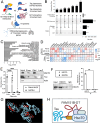A novel lncRNA FAM151B-DT regulates degradation of aggregation prone proteins
- PMID: 41053434
- PMCID: PMC12602342
- DOI: 10.1038/s41380-025-03277-6
A novel lncRNA FAM151B-DT regulates degradation of aggregation prone proteins
Abstract
Neurodegenerative diseases share common features of protein aggregation along with other pleiotropic traits, including shifts in transcriptional patterns, neuroinflammation, disruption in synaptic signaling, mitochondrial dysfunction, oxidative stress, and impaired clearance mechanisms like autophagy. However, key regulators of these pleiotropic traits have yet to be identified. Here, we used transcriptomics, mass spectrometry, and biochemical assays to define the role of a novel lncRNA on tau pathophysiology. We discovered a long non-coding RNA (lncRNA), FAM151B-DT, that is reduced in a stem cell model of frontotemporal lobar dementia with tau inclusions (FTLD-tau) and in brains from FTLD-tau, progressive supranuclear palsy, Alzheimer's disease, and Parkinson's disease patients. We show that silencing FAM151B-DT in vitro is sufficient to enhance tau and α-synuclein aggregation. To begin to understand the mechanism by which FAM151B-DT mediates tau aggregation and contributes to several neurodegenerative diseases, we deeply characterized this novel lncRNA and found that FAM151B-DT resides in the cytoplasm where it interacts with tau, α-synuclein, HSC70, and other proteins involved in protein homeostasis. When silenced, FAM151B-DT blocks autophagy, leading to the accumulation of tau and α-synuclein. Importantly, we discovered that increasing FAM151B-DT expression is sufficient to promote autophagic clearance of phosphorylated tau and α-synuclein, and reduce tau and α-synuclein aggregation. Overall, these findings pave the way for further exploration of FAM151B-DT as a promising molecular target for several neurodegenerative diseases.
© 2025. The Author(s).
Conflict of interest statement
Competing interests: CMK serves as an advisor for Eisai Co. Ltd. PTK receives research support from Biogen Inc. DDD and PTK have ownership interest in Helical Biosciences LLC. Ethics approval and consent to participate: The informed consent was approved by the Washington University School of Medicine Institutional Review Board and Ethics Committee (IRB 201104178 and 201306108). The University of California San Francisco Institutional Review Board approved the operating protocols of the UCSF Neurodegenerative Disease Brain Bank (from which brain tissues were obtained). Participants or their surrogates provided consent for autopsy, in keeping with the guidelines put forth in the Declaration of Helsinki, by signing the hospital’s autopsy form. If the participant had not provided future consent before death, the DPOA or next of kin provided it after death. All data were analyzed anonymously.
Figures






Update of
-
A novel lncRNA FAM151B-DT regulates autophagy and degradation of aggregation prone proteins.medRxiv [Preprint]. 2025 Jan 24:2025.01.22.25320997. doi: 10.1101/2025.01.22.25320997. medRxiv. 2025. Update in: Mol Psychiatry. 2025 Dec;30(12):5637-5651. doi: 10.1038/s41380-025-03277-6. PMID: 39974060 Free PMC article. Updated. Preprint.
References
MeSH terms
Substances
Grants and funding
- R01 NS110890/NS/NINDS NIH HHS/United States
- NS110890/U.S. Department of Health & Human Services | NIH | National Institute of Neurological Disorders and Stroke (NINDS)
- U54 NS123985/NS/NINDS NIH HHS/United States
- U01 NS110436/NS/NINDS NIH HHS/United States
- P30 CA091842/CA/NCI NIH HHS/United States
- R01 NS097799/NS/NINDS NIH HHS/United States
- K01 AG083215/AG/NIA NIH HHS/United States
- R56 NS110890/NS/NINDS NIH HHS/United States
- NS110436/U.S. Department of Health & Human Services | NIH | National Institute of Neurological Disorders and Stroke (NINDS)
- RF1 NS110436/NS/NINDS NIH HHS/United States
- RF1 NS110890/NS/NINDS NIH HHS/United States
- AG083215/U.S. Department of Health & Human Services | NIH | National Institute on Aging (U.S. National Institute on Aging)
- NS097799/U.S. Department of Health & Human Services | NIH | National Institute of Neurological Disorders and Stroke (NINDS)
- P30 DK020579/DK/NIDDK NIH HHS/United States
- UL1 TR002345/TR/NCATS NIH HHS/United States
- NS123985/U.S. Department of Health & Human Services | NIH | National Institute of Neurological Disorders and Stroke (NINDS)
LinkOut - more resources
Full Text Sources
Miscellaneous

